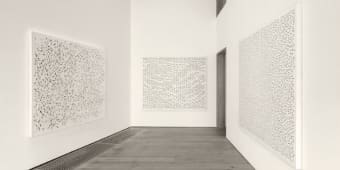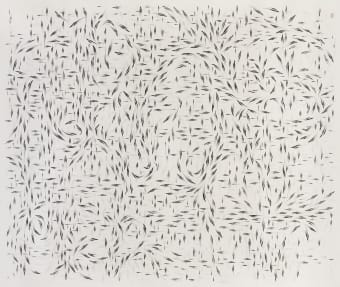|
In traditional Chinese cosmology, all forms of existence (万物 wan wu) arise from an unfolding process of differentiation and complexification. At the lowest or most base level of this process is the differentiation between 阴 yin (the feminine or negative principle in nature) and 阳 yang (the masculine or positive principle in nature) and the "Five Elements" or "Five Phases" (五行 wuxing).
Everyone has heard of yin-yang and the Five Phases but does anyone really know what yin-yang is and specifically how it produces the Five Phases?
Huang Zhiyang started his Three Marks series in 2004 to explore this most fundamental level of Chinese cosmology. In Chinese, the series is titled 千灵显 qian ling xian. Qian means "a thousand," a countable but extremely large number. Ling means "spirit" which you can think of as a bundle of "energy" — the animating spirit(s) of the cosmos. Xian means "to appear" as when a spider's silk thread hidden in shadow appears to your senses when the light hits it at just the right angle.
Each "spirit" consists of a series of brush strokes — each stroke is a basic gestural quantum of energy or 气 qi. Three strokes compose a basic flame-like form, three forms make a spirit.
At one end, all of the strokes gather together or cohere at a single point — this is yin; at the other end, the strokes differentiate and spread outward — this is yang. Each "spirit" is thus a combination of yin and yang — specifically, it is a yin-yang dipole (fig. 2).
Dipoles are everywhere in nature and are one of the fundamental building blocks of the physical world. For example, water is a dipole (in the physical configuration of the H2O bonds, the oxygen side carries a net [-] charge and the H2 side a net [+] charge) and its chemical properties as a versatile solvent derive from its dipole nature. Lipids (long-chain fat molecules) are also dipoles and because of this spontaneously form lipid membranes that shape the cellular walls.
From these dipoles, Huang Zhiyang creates different configurations and arrangements resulting in a coherent pattern each with its own qualities and characteristics. In Three Marks Mountain Spirit No. 1306, all of the dipoles are arranged in the same orientation like a crystal; this lattice, however, includes natural imperfections very like a metal (fig. 3). In Three Marks Mountain Spirit No. 1307, the dipoles are arranged vertically (blue) and horizontally (green) (fig. 4). The symmetry of the first configuration has been broken so that now we have up and down, right and left — the pattern is ordered but much more heterogeneous. Finally, we have a pattern without a lattice or grid; instead, each spirit is moving or flowing as in a turbulent fluid (fig. 5).
The Greek notion of the Five Elements is based on the notion of universal substances each with its own essence. In the Chinese notion, matter is made of the same essential substance — energy or qi — but arranges in different yin-yang configurations. Thus, the Chinese cosmology is less a theory of "elements" than a theory of "energy phases states" — analogous to the phase states of matter as solid, liquid, gas, plasma, etc.
In his Three Marks series, Huang Zhiyang has transformed a theoretical construct into a perceptual experience — he has turned something rational into something experiential and transferred analytic understanding into aesthetic intuition. Take, for example, the place where two yin points meet; the feeling you experience is one of calmness and stillness — one of the defining qualities of yin. In contrast, the place where two yang points meet, the feeling is one of tension and expansion — one of the defining qualities of yang. Your understanding of these qualities is no longer conceptual; rather — with Huang's help — it is now directly perceivable. |
Huang Zhiyang: Three Marks series
Craig Yee
INKstudio 墨齋
Tel: +86 10 6435 3291
Red No. 1-B1, Caochangdi
Chaoyang District, Beijing, China 100015
Tuesday - Sunday 10.00am - 6.00pm
Facebook, opens in a new tab.
Instagram, opens in a new tab.
Weibo, opens in a new tab.
Join the mailing list
Send an email
View on Google Maps
Copyright © 2025 INKstudio
This website uses cookies
This site uses cookies to help make it more useful to you. Please contact us to find out more about our Cookie Policy.

, 2013, ink and mineral pigments on silk, 200 x 240 cm.jpg)

, 2013, ink and mineral pigments on silk, 200 x 240 cm.jpg)

, 2013, ink on silk, 200 x 240 cm.jpg)

